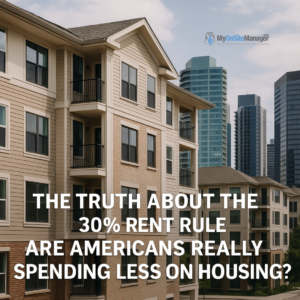The conversation about housing affordability continues to dominate headlines—and for good reason. For millions of Americans, rent is the single largest monthly expense, often dictating how much remains for savings, healthcare, groceries, and other essentials. According to a recent Yahoo Finance report, U.S. renters spent an average of 23.4% of their income on rent in April 2025, a figure that falls below the widely accepted “30% rule” for housing affordability (Yahoo Finance).
At first glance, this might seem like good news. If renters are spending less than 30% of their income on rent, doesn’t that mean the affordability crisis is easing? Unfortunately, the story is far more complex. Averages can paint a misleading picture, masking the very real struggles faced by many renters across the country.
What Does the 30% Rule Really Mean?
The “30% rule” is often used as a benchmark for housing affordability. The idea is simple: if you spend 30% or less of your gross income on housing, you are considered to have an affordable living arrangement. This threshold, however, was developed decades ago and may no longer reflect modern realities.
-
Rising costs: In many U.S. cities, rents have surged faster than wages, meaning that even a household spending 30% of their income on rent might still feel stretched thin.
-
Lower incomes: For low-income households, spending 30% on rent often means sacrificing essential expenses like healthcare or savings.
-
Changing lifestyles: With student debt, inflation, and stagnant wage growth, younger renters are more likely to exceed this threshold than previous generations.
The Gap Between Averages and Reality
While the national average rent burden is 23.4%, this number doesn’t tell the full story. Studies reveal that around 40% of middle-income renters are still exceeding the 30% benchmark, and in high-demand metropolitan areas, this number is even higher.
Consider these disparities:
-
Urban vs. Rural: Renters in major cities such as New York, San Francisco, and Los Angeles often pay upwards of 40-50% of their income on rent due to limited housing supply and soaring demand.
-
Younger Generations: Millennials and Gen Z renters—already burdened with student loan payments—are among the hardest hit.
-
Low-Income Households: For those at the lower end of the income scale, even spending 20% of their income on rent can cause financial strain.
Why Are Rents Stabilizing Now?
The Yahoo Finance report suggests that the rental market is showing signs of stabilization, thanks in part to a slowdown in post-pandemic demand spikes. In some cities, new housing developments and rental incentives are helping keep costs steady. However, this stabilization is uneven—high-demand markets continue to experience tight supply and elevated prices.
Factors influencing rental trends include:
-
Post-Pandemic Adjustments: Rents surged in 2021-2023 due to demand spikes. With the market balancing out, some regions are seeing slower rent growth.
-
Interest Rates & Homeownership: Higher interest rates are discouraging home purchases, forcing more people to stay in the rental market, which can push prices upward in certain areas.
-
Wage Growth: While wages have increased slightly, they haven’t kept pace with the cost of living in many regions.
Why the 30% Rule May Be Outdated
Economists argue that the 30% rule is a blunt tool for measuring affordability. For some high-income households, spending 35% on rent might still leave plenty for savings and discretionary spending. Conversely, a low-income renter spending 20% of their earnings on rent might still struggle to cover other essentials.
Key takeaways:
-
Affordability should be measured by residual income (what’s left after paying rent) rather than a fixed percentage.
-
Housing policies and programs should consider regional variations, as a $1,500 rent might be manageable in some cities but crushing in others.
-
The rule does not account for other financial burdens like student loans, medical expenses, or childcare.
What Can Renters Do?
If you find yourself paying more than 30% of your income on rent—or simply want to free up more of your paycheck—here are a few strategies:
-
Negotiate Your Lease: Landlords may offer lower rents or incentives to reliable tenants, especially in competitive markets.
-
Consider Roommates or Shared Housing: While not ideal for everyone, shared living arrangements can significantly reduce rent costs.
-
Explore Housing Assistance Programs: Many states and cities offer rental relief or subsidies for qualifying households.
-
Budget & Plan Ahead: Understanding your financial picture and creating a rent-to-income plan can help you avoid overspending.
The Bigger Picture: Policy and Change
The affordability crisis isn’t just a renter’s problem—it’s a national issue. Policymakers are exploring solutions such as increasing housing supply, reforming zoning laws, and offering tax credits for renters. Without systemic changes, the gap between average statistics and individual struggles will continue to grow.
Final Thoughts
While the 23.4% rent-to-income ratio suggests that U.S. renters are, on average, below the 30% affordability threshold, this number oversimplifies a much more nuanced reality. Millions of renters—especially in expensive cities—are still struggling with rent burdens that far exceed 30%, leaving little room for financial security or upward mobility.
Understanding your personal rent burden—and the broader factors shaping the rental market—is key to making informed decisions. Whether you’re looking for ways to cut costs, considering a move, or planning for future homeownership, knowledge is your strongest ally.

